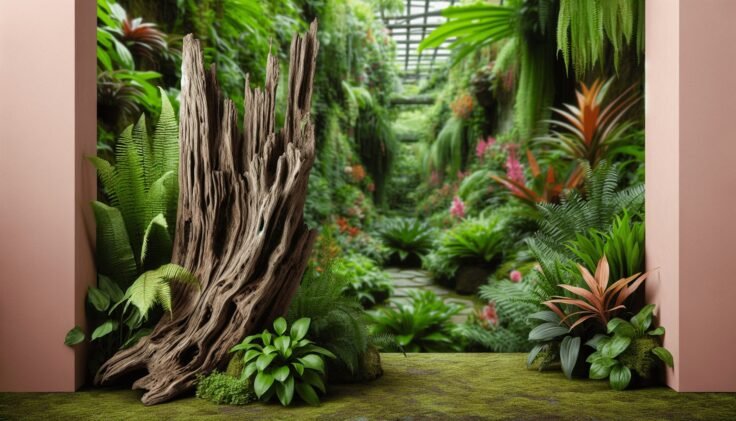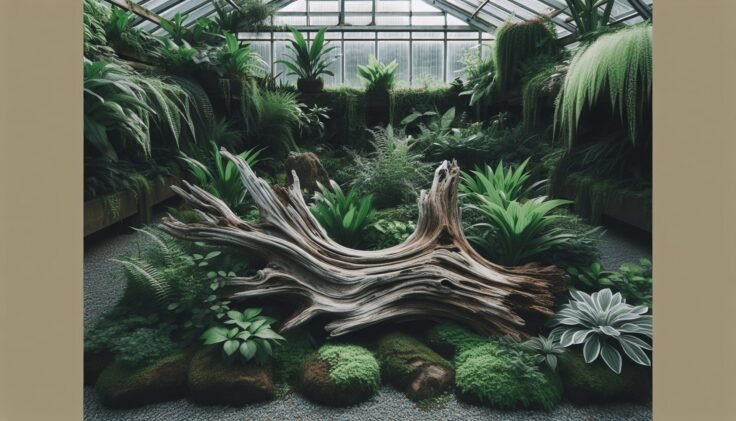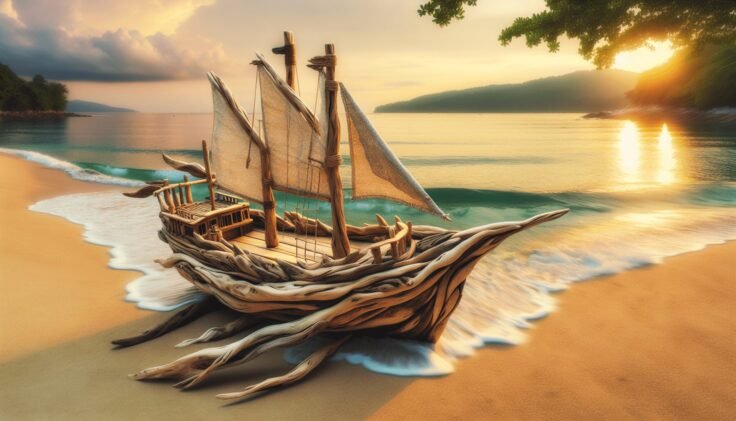Have you ever wondered how to create a captivating underwater landscape with driftwood in a 10-gallon aquarium? Aquascaping, the art of designing underwater landscapes, allows you to transform a simple fish tank into a living work of art. Using driftwood in a 10-gallon aquascape can add a natural, rustic beauty and provide both aesthetic appeal and functional benefits for your aquatic environment.

What is Aquascaping?
Aquascaping is a form of underwater gardening that involves arranging aquatic plants, substrates, rocks, and driftwood in an aesthetically pleasing way. The goal is to create a visually appealing and balanced underwater scene that mimics natural habitats. It’s an art form that requires creativity, planning, and an understanding of aquatic ecosystems.
Benefits of Aquascaping
Aquascaping offers several benefits beyond just aesthetics:
- Natural Habitat: Provides a close-to-natural habitat for fish and invertebrates.
- Stress Reduction: Watching a beautifully crafted aquascape can be very relaxing.
- Water Quality: Certain plants can help improve water quality by absorbing excess nutrients.
- Fish Behavior: Creates natural hiding and breeding places for fish.
Why 10 Gallons?
A 10-gallon tank is an excellent size for beginners and those with limited space. It’s large enough to create a visually appealing aquascape yet small enough to be manageable. Additionally, smaller tanks are typically more affordable and easier to maintain.
The Role of Driftwood in Aquascaping
Driftwood plays a crucial role in aquascaping. It can serve as a focal point, create natural hiding spots for fish, and even promote beneficial bacteria growth.
Types of Driftwood
Choosing the right type of driftwood is essential for your aquascape. Here are some popular types:
| Type of Driftwood | Description | Best Use |
|---|---|---|
| Spider Wood | Twisted branches that offer a unique, natural look. | Creating intricate designs and natural hideouts. |
| Mopani Wood | Dense wood with a dual-tone color, very durable. | Long-lasting aquascapes with a rustic feel. |
| Cholla Wood | Porous and lightweight, often used for shrimp tanks. | Short-term use; great for shrimp and small fish. |
| Manzanita Wood | Smooth branches that are easy to arrange and less likely to release tannins into the water. | Creating minimalistic and elegant designs. |
| Malaysian Driftwood | Dark-colored, heavy wood that sinks easily. | Ideal for creating darker, moody aquascapes. |
Benefits of Using Driftwood
- Aesthetic Appeal: Adds a natural, rustic look.
- Habitat: Provides hiding spots and breeding grounds for aquatic life.
- Water Chemistry: Releases tannins that can soften water and lower pH.
- Biofilm Growth: Promotes beneficial bacteria which help in breaking down waste.
Planning Your 10-Gallon Aquascape
Before you start placing driftwood and plants in your tank, it’s crucial to have a plan. Consider the following steps:
Research and Inspiration
Look up different aquascape designs to get an idea of what you like. Websites, social media channels, and aquascaping forums can be excellent resources for inspiration.
Sketch Your Design
Draw a rough sketch of your aquascape layout. This helps you visualize the final product and plan where each element will go.
Choose the Right Equipment
Ensure you have all the necessary equipment, including:
- Tank: A 10-gallon glass or acrylic aquarium.
- Filter: A suitable filter to keep the water clean.
- Heater: If you plan to keep tropical fish, you’ll need a heater.
- Lighting: Proper lighting to support plant growth.
- Substrate: Gravel, sand, or aqua soil.
Selecting Flora and Fauna
Choose plants and fish that are compatible with each other and the size of your tank. Some popular plant choices for small aquascapes include Java Moss, Anubias, and Cryptocoryne. For fish, consider small species like Neon Tetras, Bettas, or Shrimp.

Setting Up Your 10-Gallon Aquascape
Now that you have a plan and all the necessary equipment, it’s time to set up your 10-gallon aquascape.
Preparing the Driftwood
Driftwood needs to be prepared before adding it to your tank:
- Boil: Boil the driftwood to kill any parasites and remove tannins that can discolor the water.
- Soak: Soak the driftwood in water for several days to ensure it sinks.
- Scrub: Use a brush to clean the driftwood and remove any debris.
Setting the Substrate
Lay down the substrate evenly across the bottom of the tank. A thicker layer at the back can create a sense of depth.
Placing the Driftwood
Position the driftwood according to your sketch. Ensure it’s stable and won’t topple. You might need to secure it with rocks or tie it down with fishing line until it becomes waterlogged.
Adding Plants
Plant your aquatic plants around the driftwood. Use tweezers to place delicate plants into the substrate without damaging their roots. Remember to space them out to allow for growth.
Filling the Tank
Slowly fill the tank with water to avoid disturbing your carefully arranged substrate and plants. Use a plate or a bowl to break the stream of water.
Installing Equipment
Place the filter, heater, and lighting according to the manufacturer’s instructions. Ensure all equipment is working correctly before adding fish.
Cycling the Tank
Before adding any fish, you need to cycle your tank. This process involves growing beneficial bacteria to handle the waste produced by the fish. It can take anywhere from a few weeks to a month.
Introduction to Fish and Maintenance
Once your tank is cycled, you can start adding fish gradually. Monitor water parameters closely to ensure the environment remains stable.
Acclimating Fish
Acclimate new fish by floating their bag in the tank for 15-30 minutes. Gradually add small amounts of tank water to the bag to help the fish adjust to the new water conditions.
Regular Maintenance
Maintaining a 10-gallon aquascape involves regular tasks:
- Water Changes: Perform weekly water changes of about 20-30%.
- Pruning Plants: Trim plants to prevent overgrowth and maintain their shape.
- Cleaning: Clean the glass, filter, and equipment as needed.
Monitoring Water Parameters
Regularly test your water for:
| Parameter | Ideal Range |
|---|---|
| pH | 6.5-7.5 |
| Ammonia | 0 ppm |
| Nitrite | 0 ppm |
| Nitrate | Less than 20 ppm |
| Temperature | 72-78°F (22-25°C) |
Common Challenges and Solutions
Every aquascape can face challenges. Here are some common issues and how to address them:
Algae Growth
Algae can quickly become an eyesore. Control algae by:
- Reducing Light: Limit light exposure to 6-8 hours a day.
- Adding Algae Eaters: Consider adding shrimp or snails.
- Water Changes: Perform regular water changes to remove excess nutrients.
Driftwood Discoloration
Driftwood can release tannins, turning the water brown. This isn’t harmful, but can be unsightly. If this happens:
- Activated Carbon: Add activated carbon to your filter.
- Pre-soaking: Ensure you soak the driftwood thoroughly before adding it to the tank.
Plant Health
If plants aren’t thriving, consider:
- Lighting: Ensure they are getting adequate light.
- Nutrients: Use liquid fertilizers or root tabs.
- Water Quality: Maintain stable water parameters.
Fish Health
Monitor your fish for signs of stress or illness. Common signs include:
- Gasping for Air: May indicate poor water quality.
- Loss of Color: Could be caused by stress or poor diet.
- Unusual Behavior: Rapid swimming or hiding can indicate an issue.
Enhancing Your Aquascape
Once your basic setup is stable, you might want to enhance your aquascape further.
Adding More Plants
Introduce more plant species to create a diverse and lush environment. Ensure they are compatible with your existing plants and fish.
Creating Layers
Add depth to your aquascape by creating different layers. Use larger plants or stones at the back and smaller ones at the front.
Introducing Complexity
Incorporate additional elements like rocks, caves, or other decorations to add complexity and interest to your aquascape.
Advanced Techniques
Explore advanced aquascaping techniques like the Dutch style which focuses on a garden-like appearance, or the Iwagumi style, characterized by stone arrangements.
Conclusion
Creating a 10-gallon aquascape with driftwood is a rewarding endeavor that combines art and nature. With careful planning, the right materials, and regular maintenance, you can transform a small aquarium into a stunning underwater world. Remember, the key to a successful aquascape is balance—between plants, fish, and the decorative elements. Take your time, be patient, and most importantly, enjoy the process of creating your unique underwater masterpiece.

















